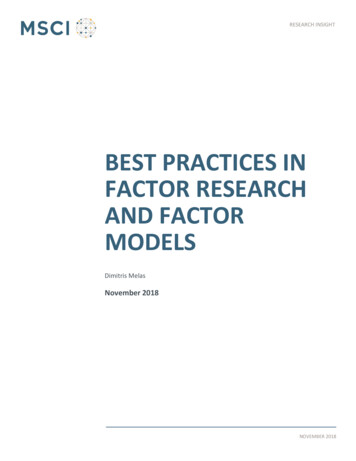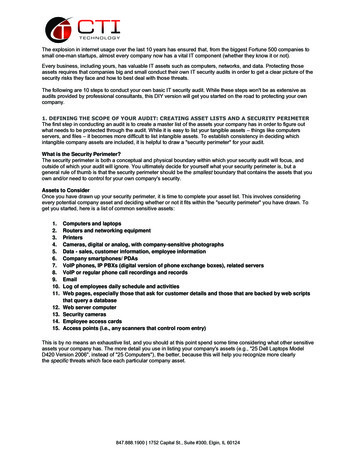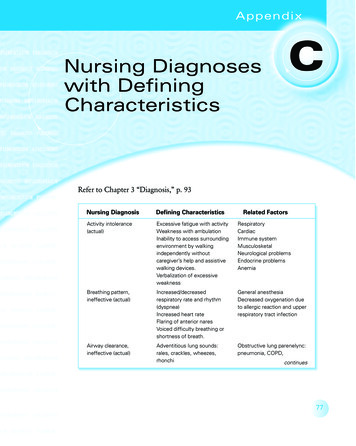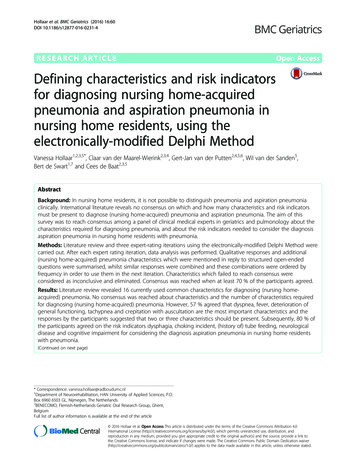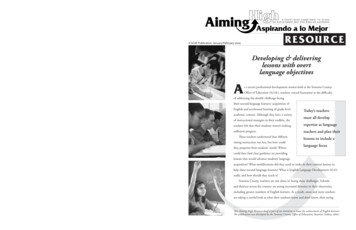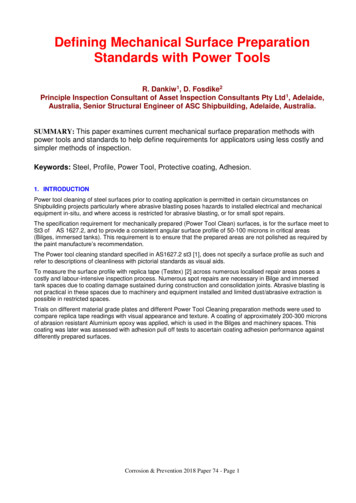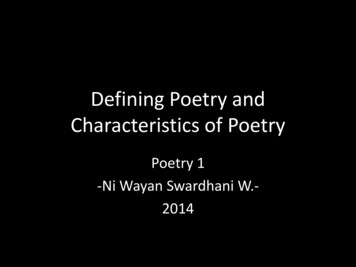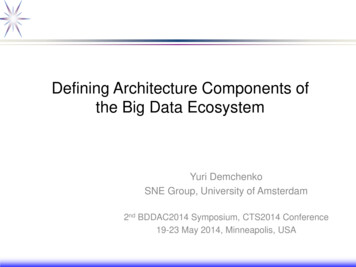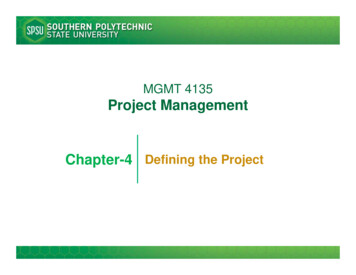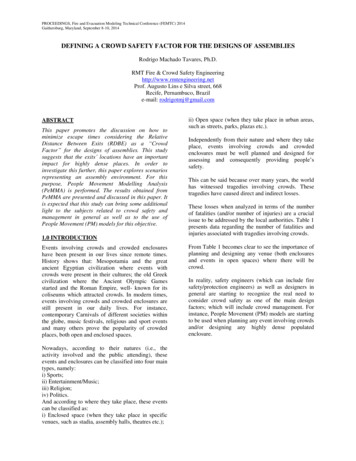
Transcription
PROCEEDINGS, Fire and Evacuation Modeling Technical Conference (FEMTC) 2014Gaithersburg, Maryland, September 8-10, 2014DEFINING A CROWD SAFETY FACTOR FOR THE DESIGNS OF ASSEMBLIESRodrigo Machado Tavares, Ph.D.RMT Fire & Crowd Safety Engineeringhttp://www.rmtengineering.netProf. Augusto Lins e Silva street, 668Recife, Pernambuco, Brazile-mail: rodrigotmj@gmail.comABSTRACTThis paper promotes the discussion on how tominimize escape times considering the RelativeDistance Between Exits (RDBE) as a “CrowdFactor” for the designs of assemblies. This studysuggests that the exits’ locations have an importantimpact for highly dense places. In order toinvestigate this further, this paper explores scenariosrepresenting an assembly environment. For thispurpose, People Movement Modelling Analysis(PeMMA) is performed. The results obtained fromPeMMA are presented and discussed in this paper. Itis expected that this study can bring some additionallight to the subjects related to crowd safety andmanagement in general as well as to the use ofPeople Movement (PM) models for this objective.1.0 INTRODUCTIONEvents involving crowds and crowded enclosureshave been present in our lives since remote times.History shows that: Mesopotamia and the greatancient Egyptian civilization where events withcrowds were present in their cultures; the old Greekcivilization where the Ancient Olympic Gamesstarted and the Roman Empire, well- known for itscoliseums which attracted crowds. In modern times,events involving crowds and crowded enclosures arestill present in our daily lives. For instance,contemporary Carnivals of different societies withinthe globe, music festivals, religious and sport eventsand many others prove the popularity of crowdedplaces, both open and enclosed spaces.Nowadays, according to their natures (i.e., theactivity involved and the public attending), theseevents and enclosures can be classified into four maintypes, namely:i) Sports;ii) Entertainment/Music;iii) Religion;iv) Politics.And according to where they take place, these eventscan be classified as:i) Enclosed space (when they take place in specificvenues, such as stadia, assembly halls, theatres etc.);ii) Open space (when they take place in urban areas,such as streets, parks, plazas etc.).Independently from their nature and where they takeplace, events involving crowds and crowdedenclosures must be well planned and designed forassessing and consequently providing people’ssafety.This can be said because over many years, the worldhas witnessed tragedies involving crowds. Thesetragedies have caused direct and indirect losses.These losses when analyzed in terms of the numberof fatalities (and/or number of injuries) are a crucialissue to be addressed by the local authorities. Table 1presents data regarding the number of fatalities andinjuries associated with tragedies involving crowds.From Table 1 becomes clear to see the importance ofplanning and designing any venue (both enclosuresand events in open spaces) where there will becrowd.In reality, safety engineers (which can include firesafety/protection engineers) as well as designers ingeneral are starting to recognize the real need toconsider crowd safety as one of the main designfactors; which will include crowd management. Forinstance, People Movement (PM) models are startingto be used when planning any event involving crowdsand/or designing any highly dense populatedenclosure.
Table 1: Number of fatalities and injuries in eventsinvolving crowds around the world.EventNumber ofFatalitiesNumber ofInjuriesHundreds(possiblythousands)HundredsRock music concert at theOhio Coliseum (1979 inCincinnati, USA)11UnknownFootball match at the Athensstadium (1981 in Athens,Greece)24Unknown(possiblyhundreds)Football match at theMoscow s Lenin stadium(1982 in Moscow, Russia)340UnknownHindu pilgrimage inHardwar, India (1986)46UnknownFootball match at theHillsborough stadium (1989in Sheffield, UK)94174muslim annual pilgrimage atMecca (1990 in Mecca,Saudi Arabia)1426Hundreds(possiblythousands)Love Parade disaster (2010in Duisburg, Germany)21More than500Joseph Stalin’s funeralprocession (1953 inMoscow, Russia)2.0 PEOPLE MOVEMENT (PM) MODELSComputational simulation models which representpeople’s movement under emergency conditions (i.e.,fires, earthquakes, flooding, bomb threats etc.) andnon-emergency situations (i.e., circulation of people,urban planning etc.) have been developed largelyover the last two decades. Considering their state-ofthe-art concept, these models are still commonlycalled as models, egress models, crowd simulationmodels etc. These models can simply be designatedas People Movement (PM) models, since this is whatthey do: they model people movement.The PM models can be used in a wide field ofapplications, such as: fire safety engineering;circulation of people in open and enclosedenvironments; risk analysis in major events involvingcrowds (i.e., crowd management and crowd safety);studies on human behaviour during emergencysituations etc. Figure 1 summarizes the applicationsfor PM models.In Figure 1, the acronyms mean:- FSE: Fire Safety Engineering;- EE: Earthquake Engineering;- TE: Transportation Engineering;- UP: Urban Planning;- CSE: Crowd Safety Engineering.2.1 The history behind the development of PMmodelsNowadays, there are many PM models available; infact, there are currently more than 40 PM models.These models take into account not only the physicalattributes of the occupants, but also theirpsychological attributes (i.e., competitive behaviour,response time etc.). Some well-known PM modelsare continually updated and improved to take intoaccount new research in the field.PM models were initially developed within the FireSafety Engineering field for helping firesafety/protection engineers to develop their firesafety strategies based on performance-basedapproaches (i.e., fire engineering solutions). Indeed:“Designers and regulators are consequently turning ed by the new generation of people movementmodels” [1].For instance, under this perspective, the concepts ofASET and RSET were introduced in the BritishStandards (BS) 7974 ‘The application of fire safetyengineering principles to fire safety design ofbuildings’ part 6 [2]. In section 6.7.2 of thisdocument, it states:“To ensure the safety of the occupants of abuilding, it is necessary to establish that they areable to reach a place of safety before untenableconditions occur. The time necessary for evacuationof the occupants to a place of safety will depend on anumber of factors relating to the occupants, thebuilding and the rate at which the fire gives rise tountenable conditions. The aim is to ensure that allpersons can leave a threatened part of a building inreasonable safety without assistance and the aim isgenerally to ensure that the time available for escapeis greater than the time required for escape”:ASET RSETWhere:ASET is the Available Safe Egress Time (beforeuntenable conditions occur);RSET is the Required Safe Egress Time.Figure 1: Examples of applications for PM models2
It is possible to get a reasonable good estimation ofthe RSET in simple geometries (i.e., relatively lowpopulated buildings and/or small buildings) by usingthe hand calculation approach suggested in thisdocument. However, in highly populated enclosuresand complex geometries, the interaction between theoccupants potentially produces significant areas ofcongestion. For this reason, alternative methods ofcalculation should be considered, such as the use ofcomputational simulation models which representpeople movement: PM models. This discussion onthe use of PM models within the Fire SafetyEngineering field is better explored in other studies[3-9]; and for this reason it will not be explored indepth in this paper.The main advantage of PM models is that they takeinto account the occupants’ Interactions (i.e.,congestions; decision-makings etc.). Besides that,most PM models allow to graphically present theinformation with little ‘‘avatars’’ moving around thespace that resembles considerably the realenvironment.Thishelpsimmenselytheunderstanding of how people move within a specificstructure under emergency conditions and also nonemergency situations. For example, their appropriateuse [4] can help designers to improve people’s flowrate (i.e., elimination and/or reduce of congestions,bottlenecks, queues etc.).More important than their sophisticated features andcapabilities, the way they are used is a core-aspect[4]. The science behind these models is described aspedestrian dynamics and there are some websitesdedicated to discuss about this topic [10].2.2 The concept of PeMMA – People MovementModelling AnalysisThe analysis before, during and after the use of anyPM model should follow a logical and reasonable setof steps: (i) appropriate use of the PM model; (ii)accurate analysis of the results from the simulations;(iii) proposition of feasible and intelligent designsolutions based on the PM modelling analysis.Furthermore, People Movement Modelling Analysis(PeMMA) should be always considered. It is not onlythe use of the PM model itself, but the way the resultsare understood and analyzed which will befundamental for assessing and addressing crowdsafety.For instance, PeMMA can include the followingskills:a) For Emergency situations:- Simulation modelling analysis combined with firemodelling analysis (when necessary);- Estimation of RSET (Required Safe Egress Time),considering detection times, pre-movement times etc;- Evaluation of stairs, corridors and pedestriantunnels widths based on their capacity in terms ofoccupants’ flow rate for different types of scenariosand occupants’ bodies and mobility;- General investigation of deviations from thebuilding regulation codes (i.e., travel maximumdistances; maximum number of persons permittedetc.) for developing performance-based solutions.In summary, for emergency situations, the PMmodels can be used for estimating the time for peopleto escape safely from events such as fires, terroristattacks (i.e., bomb-treats), earthquakes, floods,hurricanes etc.b) For Non-Emergency situations:- Maximization of the floor area usage by people;- Analysis of the lay-out impact on people’scirculation;- Minimization/Maximization of the time to be takenby people to move within specific areas;- Improvements of people’s flow rate (eliminationand/or reduce of congestions, bottlenecks, queuesetc.).For both situations, PeMMA is capable to investigatepeople movement in open spaces and enclosures, forhighly or lowly dense populated scenarios.The aim of PeMMA is to address crowd safety (andcomfort) in different complex scenarios: from hightall buildings to large highly dense populatedunderground stations.PeMMA can help immensely the understanding ofhow people move within a specific structure underemergency conditions and non-emergency situations.PeMMA can also be incorporated within the wholemanagement strategy package, i.e., crowdmanagement. For example, some of the benefits ofPeMMA can be:- enhanced life safety;- avoidance of disruption (i.e., avoidance of businesslosses);- building value (i.e., future sale) for enclosures;- cost savings elsewhere in the building design and/orevent planning;- greater design freedom.The concept of PeMMA is discussed in details inother studies developed by the author [8,9].In the next section, the scenarios which investigatedusing PM models are presented.3
3.0 THE SCENARIOSThe scenarios investigated represented a typicalassembly environment: a music concert hall/space. Asummary of these scenarios is shown in Table 2.As it is possible to see, in all of these three scenarios,the population density is high:- For Scenario 1, the population density is2.565 p/m2.- For Scenario 2, the population density is1.5375 p/m2.- For Scenario 3, the population density is2.395p/m2.For each scenario, the exits were placed in differentlocations in order to investigate their impact on theescape performance of the occupants. In other words,with this, it was attempted to see how the RDBEwould influence the escape efficiency. Figures 2, 3and 4 show these scenarios.Table 2: Summary of the scenarios used for PeMMAScenariosGeometryNumber ofExitsExit sWidthsNumberof PeopleScenario 1Squaredspace(20m X20m)Four1m each1026Scenario 2Squaredspace(40m X40m)Four1m each2460Scenario 3Squaredspace(40m X40m)One2m3832Figure 2: Exits locations for scenario 1Figure 3: Exits locations for scenario 24
The results of these simulations are presented in thenext section.5.0 RESULTS AND DISCUSSIONThe results obtained from PeMMA are shown inTable 3.Table 3: Results obtained from PeMMA for all thescenariosScenariosFigure 4: Exits locations for scenario 3In the next section, the methodology for simulatingthese scenarios is discussed.4.0 METHODOLOGYThe PM model used for performing the simulationswas the Pathfinder [11]. There are few documentspublicly available about this model [12] andtherefore, this paper will not be discussing about themodel de per se.The basic parameters used for simulating thescenarios are described in the following lines.The travel speed values adopted for the simulationsfollowed a standard normal (Gaussian) distribution,having 1.3ms as the maximum travel speed and0.8m/s as the minimum travel speed. With this, aheterogeneous population was considered for thesesimulations in order to represent realistically this typeof scenario (i.e., music concert hall/space).All the occupants ran to the nearest exit and wereallowed to overtake those which were slower.Considering also that the main purpose of this studywas to investigate the interaction between peoplestructure, there was no delay time inserted into themodel. Indeed, psychological factors were not themain concern for these scenarios, since all of themwere highly populated. For this reason, people’smovements were more driven in terms of physicalrather than psychological aspects.Exits LocationsEscapeTimesScenario1Exits located in the corners of the walls164.78secExits located in the middle of the walls215.73secScenario2Exits located in the corners of the walls96.48secExits located in the middle of the walls104.38secScenario3Exit located in the corners of the wall563.33secExit located in the middle of the wall1234.33secAs it is possible to see, the RDBE does have asubstantial impact on the people’s escapeperformance. In reality, the “corner effect” observedin previous studies becomes more evident for highdense populated environments. With thesesimulations, becomes clear how its influenceincreases proportionally to the increase of thepopulation density.For example, for scenarios 1 and 2, where thepopulation density were higher than 2, the differencebetween the lower and the upper escape times werehigher than 30%. In fact, for scenario 3, where thecomplexity of the scenario also increased (since therewas only one exit, constrained even more people’smovement flexibility), the difference between thelower and the upper escape times was higher than100%.These results reveal that the way people’s safetyshould be addressed in Crowd Safety is notnecessarily the same as the way it is addressed in FireSafety. For example, within the fire safety context,the escape time is generally thought to be (notconsidering human behaviour factors) a functionalmost exclusively dependent on the time to traveltowards the exit(s). This is probably why the traveldistances required in the fire safety codes is such abig concern when developing fire safety strategies.Nevertheless, for the crowd safety context, this is notthe case, since the population density is a majorfactor and therefore, the time spent during thecongestions is a bigger issue than the time spentduring the movement towards them exit(s).5
For instance, for typical scenarios, such as thoseshown in section 3 of this paper, it is “commonsense” to think that the best place to locate exit(s)would be in the middle of the wall(s), since it is morevisible for the occupants. This type of understandingis also probably influenced by the fire safety codes,which do emphasize the maximum travel distance ascore-factor for assessing people s safety. Figure 5illustrates this.times) were found for scenarios in where the traveldistances were bigger. This shows that the approachto be adopted for crowd safety should not be exactlythe same as the one used for fire safety.Additionally, it seems that the RDBE should beconsidered as a core crowd safety factor whenassessing people’s safety in assemblies.This paper has also demonstrated how the use ofPeople Movement (PM) models can be extremelyhelpful for crowd safety and management in general.It is expected that this paper can bring someadditional light to the subjects related to crowd safetystudies as well as the advantages of applying PMmodels for this objective.Fig. 5 Comparisons between Travel Distances fordifferent Exits locationsAs it is possible to see in Figure 5, for this space (nomatter if it is open or enclosed), the TD when the exitis located in the corner of the wall will be bigger (i.e.,approximately 1.41 times the length of the wall) thanthe TD when the exit is located in the middle of thewall (i.e., approximately 1.12 times the length of thewall).Based on that, this is why the RDBE should alwaysbe considered when assessing crowd safety in openand enclosed spaces. Furthermore, the RDBE couldbe adopted as a crowd safety factor for designingassembly types of occupancies.In the next section, some concluding remarks arepresented.6.0 CONCLUSIONSThis paper explored the influence of the positioningof exits on the escape performance of people withinhighly populated spaces. For this purpose, theinvestigated three scenarios which represented amusic concert hall/space. These investigations wereconducted through People Movement ModellingAnalysis (PeMMA).The results of the simulations revealed that therelative distance between exits (RDBE) does have asubstantial impact on the escape performance ofpeople in high dense places.With these results were also observed that that themaximum travel distance values required to be usedfor fire safety code compliance does not necessarilyproduce the minimum escape times. In reality, moreefficient escape performance (e.g., lower escape7.0 ACKNOWLEDGMENTSDr. Rodrigo Machado Tavares would like to thankMr. Bryan Klein for the good discussions aboutevacuation modeling and to the following people:Mr. Philip Richard, Mr. Samuel George, Mrs. SaraLynne Parry-Jones8.0 REFERENCES[1] Galea ER (2003) PED 2003—Pedestrian andevacuation dynamics. Proceedings of the 2ndInternational Conference; CMS Press, ISBN No. 1904521-08-8; p V;[2] BS 7974:2001 - Application of fire safetyengineering principles to the design of buildings.Code of practice;[3]Tavares, R.M., 2008. The use of a mathematicalmulticriteria decision-making model for selecting thefire origin room. Building and Environment 43 denv.2007.12.010)(Elsevier Ltd.);[4] Tavares, R.M., 2009. Evacuation processes versusevacuation models: ‘‘Quo Vadimus”? FireTechnology 45 (4), 419–430. ISBN: ,Netherlands);[5] Tavares, R.M., 2010a. (L-shaped room example)of the Ph.D. Thesis. The Use of NumericalOptimisation Techniques in Computational FireEngineering Models: A Study through EvacuationModelling Analysis. University of Greenwich,London, UK (Chapter 7);[6] Tavares, R.M., 2010b. (Literature Review) of thePh.D. Thesis. The Use of Numerical OptimisationTechniques in Computational Fire EngineeringModels: A Study through Evacuation Modelling6
Analysis. University of Greenwich, London, UK(Chapter 2);[7] Tavares, R.M., Galea, E.R., 2009. Numericaloptimisation techniques applied to evacuationanalysis. In: PED 2008 – Fourth InternationalConference on Pedestrian Dynamics, first ed.Springer, Wuppertal, Germany. ISBN: 9783642045035;[8] Tavares, R.M., Ga
document. However, in highly populated enclosures and complex geometries, the interaction between the occupants potentially produces significant areas of congestion. For this reason, alternative methods of calculation should be considered, such as the use of computational simu
